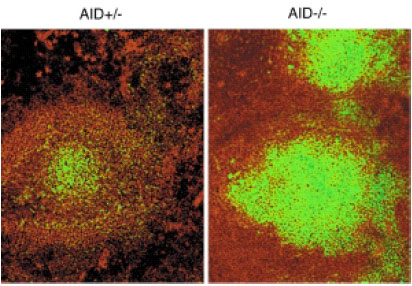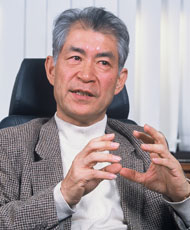Life Drama, a Scenario of the Genomethat Requires Adlib:
Strategy of the Immune System
One of the most striking messages by the complete nucleotide sequence determination of the human genome is that the number of genes in the human genome is approximately 30,000, which is only 2 folds more than that of fruit fly. This finding has raised an important and puzzling question. How can humans accomplish such sophisticated functions as nervous and immune systems by a limited number of genes?
One strategy to amplify genetic information is to alter DNA sequences themselves after birth. The immune system takes advantage of genetic alteration to amplify the genes for antigen recognition. During lymphocyte differentiation, T and B lymphocytes generate the V region of antigen receptor genes by recombination of two or three subsegments of the V region. Since each lymphocyte recombines a random pair of subsegments, each consisting of multiple copies up to 80, combination of these segments generates a huge number of antigen receptor genes. After differentiation into mature IgM-expressing B lymphocytes, antigen stimulation induces two additional types of genetic alteration in B lymphocytes which produce antibodies. First, somatic hypermutation introduces million times more frequent point mutations in the V region gene responsible for antigen recognition. This mutation can generate antibodies with higher affinity to a given antigen, allowing the antibodies to eliminate a small amount of the antigen with high efficiency. Second, class switch recombination takes place in the heavy-chain constant (C) region locus and replaces the C region with other C regions which are involved in elimination of recognized antigens. Class switch recombination gives rise to a variety of isotype classes such as IgG, IgE and IgA.
Until very recently, the molecularmechanism to accomplish class switching and somatic hypermutation was a complete mystery. Recent discovery of Activation Induced cytidine Deaminase (AID) has revealed that class switch recombination and somatic hypermutation share a common mechanism. In addition, AID is speculated to be an RNA editing enzyme from its structure, biochemical reaction and chromosomal localization. This indicates that RNA editing, another mode of the genetic alteration system is coupled with DNA alteration such as class switch recombination and somatic hypermutation. Taken together, our genome information has to be diversified and enriched by genetic alteration to accomplish higher order biological functions such as the immune defense system. Thus, the drama of life is written by a scenario that requires adlib for its sophistication.

Accumulation of germinal center B cells in AID-/- mice
The germinal center is a site where class switch recombination and somatic hypermutation take place. In the absence of AID, activated B cells accumulate and form giant germinal centers.The figure represents spleen from AID+/- and AID-/- mice. Green colour shows activity proliferating germinal center B cells.

Tasuku Honjo
Born in 1942.
Graduate of the Graduate School of Medicine, Kyoto University
Ph.D. and M.D., Kyoto University
Professor, Graduate School of Medicine, Kyoto University
URL http://www2.mfour.med.kyoto-u.ac.jp/English/Engversion.html (External Link)
"Genes hold within themselves the ability to change."
Prof. Honjo is a quiet man. But when he speaks there is a strength in his voice that makes one sense a passion welling up from deep within, like thermal energy. He says he finds immunology fascinating and began his studies in that field purely out of a desire to unravel its mysteries. He also feels fortunate to live at a time when great strides are being made in molecular biology. He plans to complete his current research in three years' time, and is carefully considering what he plans to become involved in after that. "I may become a professional golfer," he says. It will be exciting to see what unexpected adlib turns Prof. Honjo's life scenario will take in the years ahead.

